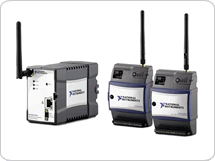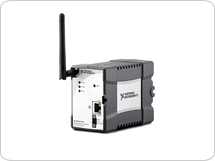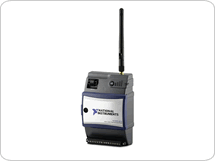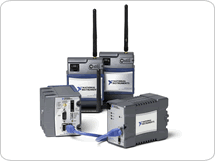|
| |
Wireless Data Acquisition might reasonably be divided into two categories,
low speed sensor networks for data logging/and limited digital IO, and higher
speed sensors on networks that support high-speed data transfer. I will
limit my discussion here to wireless networks that support multiple devices.
There also will be a number of purpose-built systems that use point-to-point
wireless connections.
High-speed networks, generally, use 802.11 b/g infrastructure, and support
data acquisition rates of up to 50 K samples/s. Wi-Fi range is variable,
but generally less than 100 m, without repeaters or other range extenders, might
be expected. Also, power requirements will restrict such devices to AC
power, or battery packs with fairly short lifetimes.
Low-speed networks offer advantages over higher speed, and the two most
obvious are reduced cost and power requirements. The reduced power
requirements make battery powered devices practical, with battery life of
several years, in some cases. Generally, such networks will employ ZigBee®
(see: http://www.zigbee.org/) architecture.
The November 2009 issue of Design World magazine published a useful article,
titled
"Are Wireless Sensor Networks really ready for industry?" Click the
link at the left to view this article.
The following are two offerings from National Instruments (I have seen these
in action, so I have some familiarity with their use).
|
National Instruments Wi-Fi Data Acquisition
|
 |
Use widespread IEEE 802.11 (Wi-Fi)
infrastructure for remote measurements |
 |
Stream data on each channel at more
than 50 kS/s with up to 24 bits of resolution
|
 |
Simplify remote monitoring with
LabVIEW and direct sensor connectivity |
 |
Protect data with 128-bit AES
encryption, the highest commercially available
standard |
 |
Seamlessly integrate wireless
measurements into existing systems |
NI Wi-Fi data acquisition (DAQ)
devices combine IEEE 802.11 wireless or Ethernet
communication; direct sensor connectivity; and the
flexibility of NI LabVIEW software for remote
monitoring and control of electrical, physical,
mechanical, and acoustical signals. NI wireless DAQ
devices can stream data on each channel at more than
50 kS/s with 24 bits of resolution. In addition,
built-in NIST-approved 128-bit AES encryption and
advanced network authentication methods offer the
highest commercially available network security.
With the flexibility of LabVIEW graphical
programming and the ubiquity of 802.11 network
infrastructure, Wi-Fi DAQ makes it easy to
incorporate wireless connectivity into new or
existing PC-based measurement or control systems.
NI wireless DAQ devices consist of an NI C Series
measurement module and a Wi-Fi carrier. The NI
WLS-9163 is a single module C Series carrier that
provides both 802.11b/g and Ethernet connectivity
back to a host PC, while the NI ENET-9163 is a
single module carrier with only Ethernet
connectivity. C Series modules provide direct sensor
connections and built-in signal conditioning for a
variety of measurements, including temperature,
strain, acceleration, current, and voltage. You can
use them interchangeably for a variety of
measurement and control applications across several
platforms, including NI CompactDAQ and CompactRIO,
and an NI single module USB carrier. You may
purchase WLS-9163 carriers and C Series modules
separately or together as NI WLS-9xxx devices:
Analog Input Devices
WLS-9211 (4-channel, 14 S/s, 24-bit, ±80 mV
thermocouple input)
WLS-9213 (16-channel, 75 S/s, 24-bit, ±80 mV
thermocouple input)
WLS-9215 (4-channel, 100 kS/s/ch, 16-bit, ±10 V
analog input)
WLS-9219 (4-channel, 100 S/s/ch, 24-bit, ±60 V, ±25
mA universal input)
WLS-9234 (4-channel, 51.2 kS/s/ch, 24-bit, ±5 V IEPE
input)
WLS-9237 (4-channel, 50 kS/s/ch, 24-bit, ±25 mV/V
bridge and strain input)
Digital I/O Devices
WLS-9421 (8-channel, 11 to 30 VDC, 24 V logic,
sinking digital input)
WLS-9472 (8-channel, 6 to 30 VDC, 24 V logic,
sourcing digital output)
WLS-9481 (4-channel, 60 VDC, 250 Vrms, SPST
electromechanical relay)
|
National Instruments Wireless Sensor
Networks
The NI wireless sensor network (WSN) platform
delivers battery-powered nodes that offer industrial
certifications, reliable networking protocols, and
optional outdoor enclosures for long-term, stand-alone
deployments. You can take advantage of NI LabVIEW
software integration with NI WSNs to select between
Windows and LabVIEW Real-Time OSs and simplify the
extraction of high-quality measurement data.
Learn more about wireless
sensor networks
|







